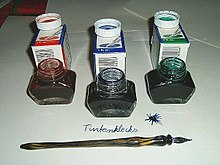Ink: Difference between revisions
Content deleted Content added
137.164.89.127 (talk) |
137.164.89.127 (talk) |
||
| Line 7: | Line 7: | ||
[[Image:Tinte1.JPG|thumb|Inkpots with penholder]] |
[[Image:Tinte1.JPG|thumb|Inkpots with penholder]] |
||
==History of ink== |
|||
Approximately 5000 years ago, an ink for blacking the raised surfaces of pictures and texts carved in stone, was developed in [[China]]. This early ink was a mixture of soot from pine smoke, lamp oil, and [[gelatin]] from animal skins and musk. Other early cultures also developed inks (of many colors) from available berries, plants and minerals. |
|||
In an article for the [[Christian Science Monitor]], Sharon J. Huntington describes these other historical inks: |
|||
<blockquote>About 1,600 years ago, a popular ink recipe was created. The recipe was used for centuries. Iron "salts," such as ferrous sulfate (made by treating iron with sulfuric acid), was mixed with tannin from gallnuts (they grow on trees) and a thickener. When first put to paper, this ink is bluish-black. Over time it fades to a dull brown.</blockquote> |
|||
<blockquote>Scribes in [[medieval]] [[Europe]] (about AD 800 to 1500) wrote on [[Sheepskin (material)|sheepskin]] parchment. One 12<sup>th</sup> century ink recipe called for hawthorn branches to be cut in the spring and left to dry. Then the bark was pounded from the branches and soaked in water for eight days. The water was boiled until it thickened and turned black. Wine was added during boiling. The ink was poured into special bags and hung in the sun. Once dried, the mixture was mixed with wine and iron salt over a fire to make the final ink.</blockquote> |
|||
In the 15<sup>th</sup> century, a new type of ink had to be developed in Europe for the [[printing press]] by [[Johannes Gutenberg]]. Two types of ink were prevalent at the time: the Greek and Roman writing ink (soot, glue, and water) and the 12<sup>th</sup> century variety composed of ferrous sulfate, gall, gum, and water <ref>Many recipes for [[iron gall ink]]s are featured in A booke of secrets: shewing diuers |
|||
waies to make and prepare all sorts of inke... tr. out of Dutch into Englishe |
|||
by W.P. [i.e. William Philip], London, 1596.</ref>. Neither of these handwriting inks could adhere to printing surfaces without creating blurs. Eventually an oily, varnish-like ink made of soot, [[turpentine]], and walnut oil was created specifically for the printing press. |
|||
Revision as of 17:06, 6 February 2007
An ink is a liquid containing various pigments and/or dyes used for colouring a surface to render an image or text. Ink is used for drawing or writing with a pen or brush. Thicker inks, in a paste form, are used extensively in letterpress and lithographic printing.

Notes
References
- "Think Ink!" by Sharon J. Huntington, Christian Science Monitor, September 21, 2004, retrieved January 17, 2006.
- "A History of Technology and Invention" by Maurice Audin, page 630
